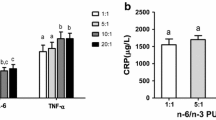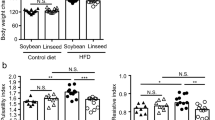Abstract
Consumption of n-3 polyunsaturated fatty acids (PUFA) is associated with a reduced incidence of atherosclerosis. Perilla oil (PO) is a vegetable oil rich in α-linolenic acid (ALA), an n-3 PUFA. In this study, antiatherogenic effects and related mechanisms of PO were investigated in atherosclerotic mice. Apolipoprotein E knockout (ApoE KO) mice (male, n = 27) were fed high-cholesterol and high-fat diets containing 10 % w/w lard (LD), PO, or sunflower oil (SO) for 10 weeks. Plasma triglyceride, total cholesterol, and low-density lipoprotein cholesterol concentrations reduced in the PO and SO groups compared to the concentrations in the LD group (P < 0.05). The PO group showed reduced fatty streak lesion size at the aortic sinus (P < 0.05) compared to the sizes in the LD and SO groups. A morphometric analysis showed enhancement of endothelial nitric oxide synthase expression and reduction of inducible nitric oxide synthase expression in the PO group compared to that in the LD group (P < 0.05). Furthermore, aortic protein expression of intercellular cell adhesion molecule 1 and vascular cell adhesion molecule 1 was diminished in the PO group compared to that in the LD and SO groups (P < 0.05). These findings suggested that PO inhibited the development of aortic atherosclerosis by improving the plasma lipid profile, regulating nitric oxide synthase, and suppressing the vascular inflammatory response in the aorta of ApoE KO mice.




Similar content being viewed by others
Abbreviations
- ABC:
-
Avidin biotin complex
- AI:
-
Atherogenic index
- AIP:
-
Atherogenic index of plasma
- ALA:
-
Alpha-linolenic acid (183n-3)
- ApoE KO:
-
Apolipoprotein E knockout
- CVD:
-
Cardiovascular disease
- DAB:
-
Diaminobenzidine hydrochloride
- DHA:
-
Docosahexaenoic acid (226n-3)
- eNOS:
-
Endothelial nitric oxide synthase
- EPA:
-
Eicosapentaenoic acid (205n-3)
- HDL-C:
-
High-density lipoprotein cholesterol
- ICAM-1:
-
Intercellular cell adhesion molecule 1
- iNOS:
-
Inducible nitric oxide synthase
- LD:
-
Lard
- LDL-C:
-
Low-density lipoprotein cholesterol
- LNA:
-
Linoleic acid (182n-6)
- NF-kB:
-
Nuclear factor kB
- NO:
-
Nitric oxide
- PO:
-
Perilla oil
- PUFA:
-
Polyunsaturated fatty acid(s)
- ROS:
-
Reactive oxygen species
- SO:
-
Sunflower oil
- TC:
-
Total cholesterol
- TAG:
-
Triacylglycerol(s)
- TNF-α:
-
Tumor necrosis factor-α
- VCAM-1:
-
Vascular cell adhesion molecule 1
References
Massaro M, Scoditti E, Carluccio MA, de Caterina R (2008) Basic mechanisms behind the effects of n-3 fatty acids on cardiovascular disease. Prostag Leukotr Ess 79:109–115
Calder PC (2006) n-3 polyunsaturated fatty acids, inflammation, and inflammatory diseases. Am J Clin Nutr 83(Suppl):1505S–1519S
Adkins Y, Kelley DS (2010) Mechanisms underlying the cardioprotective effects of omega-3 polyunsaturated fatty acids. J Nutr Biochem 21:781–792
Guallar E, Sanz-Gallardo MI, Veer PVT, Bode P, Aro A, Gómez-Aracena J, Kark JD, Riemersma RA, Martin-Moreno JM, Kok FJ (2002) Mercury, fish oils, and the risk of myocardial infarction. New Engl J Med 347:1747–1754
Burdge GC (2004) α-Linolenic acid metabolism in men and women: nutritional and biological implications. Curr Opin Clin Nutr Metab Care 7:137–144
Zhao G, Etherton TD, Martin KR, West SG, Gillies PJ, Kris-Etherton PM (2004) Dietary α-linolenic acid reduces inflammatory and lipid cardiovascular risk factors in hypercholesterolemic men and women. J Nutri 134:2991–2997
Asif M (2011) Health effects of omega-3,6,9 fatty acids: Perilla frutescens is a good example of plant oils. Orient Pharm Exp Med 11:51–59
Kurowska EM, Dresser GK, Deutsch L, Vachon D, Khalil W (2003) Bioavailability of omega-3 essential fatty acids from perilla seed oil. Prostag Leukotr Ess 68:207–212
Kim HK, Choi H (2001) Dietary α-linolenic acid lowers postprandial lipid levels with increase of eicosapentaenoic and docosahexaenoic acid contents in rat hepatic membrane. Lipids 36:1331–1336
Narisawa T, Fukaura Y, Yazawa K, Ishikawa C, Isoda Y, Nishizawa Y (1994) Colon cancer prevention with a small amount of dietary perilla oil high in alpha linolenic acid in an animal model. Cancer 73:2069–2075
Sakurai K, Asahi K, Kanesaki Y, Hayashi Y, Asai J, Yuza T, Watanabe K, Katoh T, Watanabe T (2011) Dietary perilla seed oil supplement increases plasma omega-3 polyunsaturated fatty acids and ameliorates immunoglobulin a nephropathy in high immunoglobulin a strain of ddY mice. Nephron Exp Nephrol 119:e33–e39
Kim HK, Choi H (2005) Stimulation of acyl-CoA oxidase by α-linolenic acid-rich perilla oil lowers plasma triacylglycerol level in rats. Life Sci 77:1293–1306
Kim HK, Choi S, Choi H (2004) Suppression of hepatic fatty acid synthase by feeding α-linolenic acid rich perilla oil lowers plasma triacylglycerol level in rats. J Nutr Biochem 15:485–492
Chung KH, Hwang HJ, Shin KO, Jeon WM, Choi KS (2013) Effects of perilla oil on plasma concentrations of cardioprotective (n-3) fatty acids and lipid profiles in mice. Nutr Res Pract 7:256–261
Jang JY, Kim TS, Cai J, Kim J, Kim Y, Shin K, Kim KS, Lee SP, Kang MH, Choi EK, Rhee MH, Kim YB (2014) Perilla oil improves blood flow through inhibition of platelet aggregation and thrombus formation. Lab Anim Res 30:21–27
Ide T, Murata M, Sugano M (1996) Stimulation of the activities of hepatic fatty acid oxidation enzymes by dietary fat rich in α-linolenic acid in rats. J Lipid Res 37:448–463
Okuno M, Kajiwara K, Imai S, Kobayashi T, Honma N, Maki T, Suruga K, Goda T, Takase S, Muto Y, Moriwaki H (1997) Perilla oil prevents the excessive growth of visceral adipose tissue in rats by down-regulating adipocyte differentiation. J Nutr 127:1752–1757
Hong S, Kim M, Oh C, Yoon S, Song Y (2010) Antiradical capacities of perilla, sesame and sunflower oil. J Food Sci Nutr 15:51–56
Lee OH, Lee BY, Kim YC, Shetty K, Kim YC (2008) Radical scavenging-linked antioxidant activity of ethanolic extracts of diverse types of extra virgin olive oils. J Food Sci 73:519–525
Osada J, Joven J, Maeda N (2000) The value of apolipoprotein E knockout mice for studying the effects of dietary fat and cholesterol on atherogenesis. Curr Opin Lipidol 11:25–29
Chatterjee A, Catravas JD (2008) Endothelial nitric oxide (NO) and its pathophysiologic regulation. Vasc Pharmacol 49:134–140
Li H, Horke S, Förstermann U (2014) Vascular oxidative stress, nitric oxide and atherosclerosis. Atherosclerosis 237:208–219
Esaki T, Hayashi T, Muto E, Yamada K, Kuzuya M, Iguchi A (1997) Expression of inducible nitric oxide synthase in T lymphocytes and macrophages of cholesterol-fed rabbits. Atherosclerosis 128:39–46
Djousse L, Pankow JS, Eckfeldt JH, Folsom AR, Hopkins PN, Province MA, Hong Y, Ellison RC (2001) Relation between dietary linolenic acid and coronary artery disease in the National Heart, Lung, and Blood Institute Family Heart Study. Am J Clin Nutr 74:612–619
Djoussé L, Folsom AR, Province MA, Hunt SC, Ellison RC (2003) Dietary linolenic acid and carotid atherosclerosis: the National Heart, Lung, and Blood Institute Family Heart Study. Am J Clin Nutr 77:819–825
Wei M, Xiong P, Zhang L, Fei M, Chen A, Li F (2013) Perilla oil and exercise decrease expressions of tumor necrosis factor-α, plasminogen activator inhibitor-1 and highly sensitive C-reactive protein in patients with hyperlipidemia. J Tradit Chin Med 33:170–175
Choe E (2013) Interaction of light and temperature on tocopherols during oxidation of sunflower oil. J Am Oil Chem Soc 90:1851–1857
Friedewald WT, Levy RI, Fredrickson DS (1972) Estimation of the concentration of low-density lipoprotein cholesterol in plasma, without use of the preparative ultracentrifuge. Clin Chem 18:499–502
Wang M, Liu JR, Gao JM, Parry JW, Wei YM (2009) Antioxidant activity of tartary buckwheat bran extract and its effect on the lipid profile of hyperlipidemic rats. J Agr Food Chem 57:5106–5112
Dobiasova M, Frohlich J (2001) The plasma parameter log (TG/HDL-C) as an atherogenic index: correlation with lipoprotein particle size and esterification rate in apoB-lipoprotein-depleted plasma (FERHDL). Clin Biochem 34:583–588
Leal S, Diniz C, Sa C, Goncalves J, Soares AS, Rocha-Pereira C, Fresco P (2006) Semiautomated computer-assisted image analysis to quantify 3,3′-diaminobenzidine tetrahydrochloride-immunostained small tissues. Anal Biochem 357:137–143
Longvah T, Deosthale YG (1991) Chemical and nutritional studies on Hanshi (Perilla frutescens) a traditional oil seed from Northeast India. JAOCS 68:781–784
Innis SM (2007) Dietary (n-3) fatty acids and brain development. J Nutr 137:855–859
Libby P, Ridker PM, Maseri A (2002) Inflammation and atherosclerosis. Circulation 105:1135–1143
Spady DK, Woollett LA, Dietschy JM (1993) Regulation of plasma LDL-cholesterol levels by dietary cholesterol and fatty acids. Annu Rev Nutr 13:355–381
Ihara-Watanabe M, Umekawa H, Takahashi T, Furuichi Y (2000) Comparative effects of safflower oil and perilla oil on serum and hepatic lipid levels, fatty acid compositions of serum and hepatic phospholipids, and hepatic mRNA expressions of 3-hydroxy-3-methylglutaryl CoA reductase, LDL receptor, and cholesterol 7alpha-hydroxylase in young and adult rats. Food Res Int 33:893–900
Djoussé L, Hunt SC, Arnett DK, Province MA, Eckfeldt JH, Ellison RC (2003) Dietary linolenic acid is inversely associated with plasma triacylglycerol: the National Heart, Lung, and Blood Institute Family Heart Study. Am J Clin Nutr 78:1098–1102
Davignon J, Ganz P (2004) Role of endothelial dysfunction in atherosclerosis. Circulation 109:III-27–III-32
Wilcox JN, Subramanian RR, Sundell CL, Tracey WR, Pollock JS, Harrison DG, Marsden PA (1997) Expression of multiple isoforms of nitric oxide synthase in normal and atherosclerotic vessels. Arterioscl Throm Vas 17:2479–2488
Buttery LD, Springall DR, Chester AH (1996) Inducible nitric oxide synthase is present within human atherosclerotic lesions and promotes the formation and activity of peroxynitrite. Lab Invest 75:77–85
Detmers PA, Hernandez M, Mudgett J, Hassing H, Burton C, Mundt S, Chun S, Fletcher D, Card DJ, Linsnock JM, Weikel R, Bergstrom JD, Shevell DE, Hermanowski-Vosatka A, Sparrow CP, Chao YS, Rader DJ, Wright SD, Puré E (2000) Deficiency in inducible nitric oxide synthase results in reduced atherosclerosis in apolipoprotein E-deficient mice. J Immunol 165:3430–3435
Ren J, Chung SH (2007) Anti-inflammatory effect of α-linolenic acid and its mode of action through the inhibition of nitric oxide production and inducible nitric oxide synthase gene expression via NF-κB and mitogen-activated protein kinase pathways. J Agr Food Chem 55:5073–5080
Zhang W, Fu F, Tie R, Liang X, Tian F, Xing W, Li J, Ji L, Xing J, Sun X, Zhang H (2013) Alpha-linolenic acid intake prevents endothelial dysfunction in high-fat diet-fed streptozotocin rats and underlying mechanisms. Vasa 42:421–428
Cohen SL, Moore AM, Ward WE (2005) Flaxseed oil and inflammation-associated bone abnormalities in interleukin-10 knockout mice. J Nutr Biochem 16:368–374
Winnik S, Lohmann C, Richter EK, Schafer N, Song WL, Leiber F, Mocharia P, Hofmann J, Klingenberg R, Boren J, Becher B, FitzGerald GA, Luscher TF, Matter CM, Beer JH (2011) Dietary α-linolenic acid diminishes experimental atherogenesis and restricts T cell-driven inflammation. Eur Heart J 32:2573–2584
Acknowledgments
This work was supported by a 2-Year Research Grant from Pusan National University.
Author information
Authors and Affiliations
Corresponding author
Ethics declarations
Conflict of interest
The authors have declared no conflict of interest.
About this article
Cite this article
Hong, S.H., Kim, M., Noh, J.S. et al. Perilla Oil Reduces Fatty Streak Formation at Aortic Sinus via Attenuation of Plasma Lipids and Regulation of Nitric Oxide Synthase in ApoE KO Mice. Lipids 51, 1161–1170 (2016). https://doi.org/10.1007/s11745-016-4188-z
Received:
Accepted:
Published:
Issue Date:
DOI: https://doi.org/10.1007/s11745-016-4188-z




